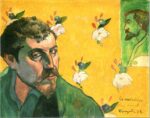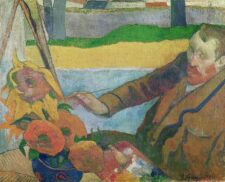
Paul Gauguin
French, 1848-1903
Bretonne de Pont-Aven de Profil (study for Four Breton Women Dancing), 1886
watercolor and black crayon on paper
7 7/8 x 5 1/2 in.
Private Collection

Gauguin - Self-Portrait Dedicated to Vincent Van Gogh, 1888
“In general, Vincent and I see eye to eye on very little, especially on painting. He admires Daudet, Daubigny, Ziem and the great Rousseau, all of them people I can’t stand. And on the other hand, he detests Ingres, Raphael, Degas, all of them people whom I admire; I reply, you’re right, soldier, for the sake of a quiet life. He likes my paintings very much, but when I’m doing them, he always finds that I’m wrong in this and that. He’s a romantic, and I’m more drawn towards a primitive condition. From the point of view of color, he sees the possibilities of impasto, as in Monticelli, and I detest manipulated brushwork and so on.”
– Letter from Gauguin to Bernard, November 1888

Gauguin – Van Gogh Painting Sunflowers, 1888
COMMENTS
Depicting a profile of a woman clad in a typical Breton costume and seen against a backdrop of a landscape, this work is a study for the figure on the left of the composition Bretonnes causant [“Four Breton Women Dancing”] painted in the same year, one of the most important canvases inspired by Gauguin’s first visit to Pont-Aven. Gauguin stayed in Pont-Aven in Brittany from July to October 1886, and executed individual studies of the female figures from direct observation; the final canvas was completed later in his studio. The subject of this work is possibly a woman known only by her first name, Louise, one of the maids who worked at the guesthouse Gloanec where Gauguin stayed.
The artist first traveled to Pont-Aven following his desire to leave Paris in pursuit of unspoiled scenery and a simple way of life away from the metropolis. For Gauguin and a number of his contemporaries, the appeal of this part of France, virtually untouched by the effects of progress, was in the raw originality of its landscape and the traditional way of life of its inhabitants. In a letter to his friend Schuffenecker, Gauguin wrote: ‘I love Brittany which I find savage and primitive. When my clogs ring on the granite ground I hear the dull and powerful sound that I am looking for in painting’ (quoted in Victor Merlès (ed.), Correspondence de Paul Gauguin, Paris, 1984, letter 141, p. 172).
https://www.sothebys.com/en/auctions/ecatalogue/2014/impressionist-modern-art-evening-sale-l14002/lot.49.html
In 1886, Gauguin settled in Pont-Aven, a small coastal village in Brittany. Here he devoted himself entirely to painting. In “Bretonnes causant” the depiction of local costumes and dancing shows the painter's interest in Breton peasant life.
Although this work represents Breton subject matter, it was probably painted from memory and from sketches back in Paris in the winter of 1886-87, an indication that Gauguin was already edging towards the synthetist treatment for his subjects by this time. The forms have been deliberately flattened, with attention paid to the white headdresses and small shawls worn by the women, and a deliberate suppression of atmosphere and distance within the picture space by avoidance of a horizon and by the use of saturated colors.
Despite its authentic 'primitive' feel, the work is an elaborate fiction. The fancy dresses that the women are wearing had been abandoned by the Breton peasantry except for the celebration of pardons, and they were enjoying a period of relative prosperity, in part financed by a flourishing tourist trade. By painting works like this from memory, Gauguin could confect a vision of Breton life that was much closer to his notion of what constituted a 'primitive' existence than any that he could have found at this time.
https://www.wga.hu//html_m/g/gauguin/02/1ponta02.html
SBMA CURATORIAL LABELS
To Gauguin, the unspoiled rusticity of Pont Aven in Brittany felt “savage and primitive,” compared to the slick urbanity of Paris. This study is one of several that date to Gauguin’s first trip to Pont Aven in 1886. The distinctive shape of the woman’s traditional headdress became a common feature of the works produced by the artists who gathered in Pont Aven, likewise the jewel-like tones, bounded by contour lines, and overall flatness, seen here. An inscription to the extreme right edge of the watercolor commemorates Gauguin’s friendship with Émile Bernard, for whom it was a gift. Bernard worked closely alongside Gauguin during these years and was also one of the few artists who remained close to Van Gogh once he had removed himself from Paris to the South of France.
- Through Vincent's Eyes, 2022
